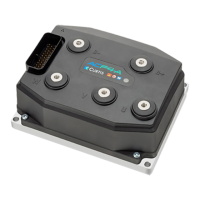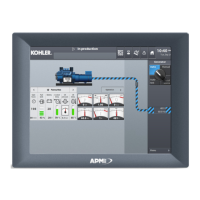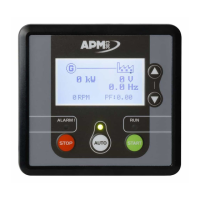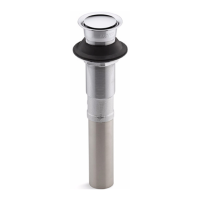6 — COMMISSIONING
Curtis AC F2-A, F4-A, F6-A Motor Controllers – FOS 4.5 – April 2022 Return to TOC
pg. 180
Table 21 Motor Characterization and Parameter Mismatch Error Types, cont’d
VARIABLE RANGE DESCRIPTION
Fault Types
5 = Interlock Brake Control Mode is invalid.
6 = PMAC_Short_Circuit_Current set above Base_Current_Limit in a
non-test mode.
7 = In a differential steer system, fault actions are miscongured.
8 = Dual motor type must be Differential.
9 = PMAC EMF Restriction - In a PMAC application congured for
restricted mode operation, the back EMF per speed value is
not congured.
10 = PMAC Release - A restricted and test mode for PMAC is being
used in released software.
11 = Torque preload is congured to be saved across key-cycles, but
EM Brake preload torque is not set.
12 = Invalid Torque Estimate - Congured torque estimation type is
incompatible with the selected ""Direct Torque"" control mode.
13 = Command Map Stop - [STEERING] CommandMapLeftStop or
CommandMapRightStop equals zero.
14 = [STEERING] Improper sequence of the redundant Command
Analog map points.
15 = Analog Feedback Maps - [STEERING] Primary or Secondary
Analog Feedback maps do not have continuous slope.
16 = Sawtooth Command - [STEERING] For Sin/Cos or Sawtooth
Command device selection, the primary and secondary types do
not match.
17 = Sawtooth Feedback - [STEERING] For Sin/Cos or Sawtooth
Feedback device selection, the primary and secondary types do
not match.
18 = Feedback Type - [STEERING] Autocenter is declared as Never
and the feedback device type is a relative position device type.
19 = Interlock braking supervision must be enabled in PMAC if
interlock braking is on.
20 = The selected motor type has not been fully characterized and
should only be used for development.
21 = R_sys did not commission properly. Contact Curtis.
100 = Parameter integrity problem.
ese next tests require the vehicle to be on the ground, able to operate/drive. Ensure there are no
tools and objects on/near the traction, moving steering components/system, and any other vehicle
wheels and tyres. Always operate the vehicle in a safe test area, where protection for personnel and
property from un-controlled operation is veried. Ensure the vehicle brakes operate, including
the EM Brake and Emergency Reverse, if so equipped.
13. Cycle (keyswitch) power. e motor control should now be operational, though likely poorly
optimized. e SlipGain test is very important. Perform the SlipGain test and get the result.
e following steps will complete the optimization process.
14. Run the SlipGain test (do not skip this critical step). is test requires the vehicle to be on the
ground, able to apply traction torque to the road.
Adjust the SlipGain parameter to provide maximum torque at stall (0 rpm motor speed). Note
that the present SlipGain value in Programmer was determined by the auto-characterization
procedure, and is not the default value.
Programmer: Motor Setup » Induction Motor (ACIM) » Characterization Tests » SlipGain.

